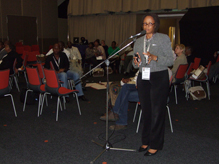
Dr Mothomang Diaho, head of the Foundation’s Dialogue Programme
April 7, 2009 – How do we ensure that all the advances in science and all the available evidence on HIV/AIDS get through to communities in order to achieve the transformation they want?
This was the question that Mothomang Diaho, Head of the Dialogue Programme at the Nelson Mandela Foundation, opened with at the fourth Southern African AIDS Conference in Durban last week. She was speaking at the “Starting Where Communities Are” satellite session.
The session introduced the Community Capacity Enhancement methodology (CCE) as a way of addressing issues surrounding HIV/AIDS.
Tom Mkhize, an international consultant on CCE, facilitated the session and explained the use of the “four quadrants” tool as an approach to change. The quadrants are: an individual’s internal development; the way an individual performs in the world; the cultural realm of a group; and the way a group operates as a system. In other words, the quadrants are individual internal, individual external, collective internal and collective external.
The participants at the session broke into four groups and moved through the process among themselves, guided by questions that tackled each of the quadrants, testing the CCE tool.
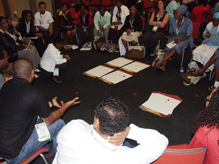
One of the break-away groups at the dialogue session
Among the people attending were members of the KwaMakhutha community, who started using the CCE approach in March and will be holding community conversations once a month. These conversations are part of CCE and get communities talking about what they would like to change and how.
Lesley Nkosi, the key facilitator of the Nelson Mandela Foundation’s community conversations, said about 280 people, 120 of them school children, attended the KwaMakhutha community conversation programme in March.
“The intention of these conversations is to establish relationships, identify concerns, explore these concerns, take decisions and then implement the decisions,” explained Nkosi.
“What we have found about KwaMakhutha is that they have made progress in working with their local council since the inception of the community conversations,” he added.
“It was exciting to find out that the facilitators have been given their own office by the council.”
Nkosi emphasised the importance of communities being self-sufficient and self-reliant.
“Although the facilitators need other resources, the office is a start and shows what an impact community conversations can have, given time,” he said.
The conversations form and foster relationships between communities and stakeholders. These relationships can yield positive results in the continuing struggle against HIV/AIDS.

Delegates pay attention during the presentation
The session’s theme, “Starting Where Communities Are”, was a true reflection of the Foundation’s approach to conversations, Nkosi said. Change was coming from within people and not being forced on them.
“It shows how you can build capacity and confidence, and once you’ve built confidence in one person, you can change the world.”
Metro FM’s Criselda Kananda attended the session so that she could learn more about CCE and introduce it to her listeners on her Thursday evening radio show, Positive Talk.
“What we (Metro FM) are looking at is how to simplify the existing interventions, especially in the scientific community, in a language everyone can understand,” she said.
Kananda chose to attend the Foundation’s session because “it’s rare to see this – you normally have a plenary sitting at the top and an audience, all formal. I believe this model can work for the Southern African region. We can’t have ‘one size to fit all’ and this process addresses that and takes the individual into consideration.”
Kananda emphasised that for too long HIV had been regarded as “someone else’s business”. She said, “It’s about time people took ownership.”
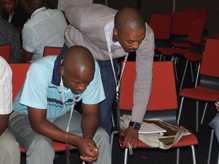
Facilitator Lesley Nkosi and a delegate get involved in the CCE process
After the break-away sessions the audience members spoke about the process they had just been involved in.
Zithulele Ntuli, a ward councillor in KwaMakhutha, said, “We know the problems and we know the solutions. My concern is, why don’t we take the solutions to the people? I believe this is what the people in the communities need. As much as we talk about it, the real solutions are with the people affected and infected.”
Kopano from Rustenburg, said, “I’ve realised how uncomfortable it is to bring an issue to me to talk about myself.”
Also from KwaMakhutha, Nokukhanya Biyase concurred with Ntuli and added, “My concern is that we see people talking about preventing the virus. What about the people who already have the virus; where do they go?”
On exploring concerns, a stage in the six step CCE process, Alexio Mboleko, from Zimbabwe, said, “The biggest problem I see is that policy-makers forget that communities already have visions of their own. They must work with communities and not drop visions down on them.”
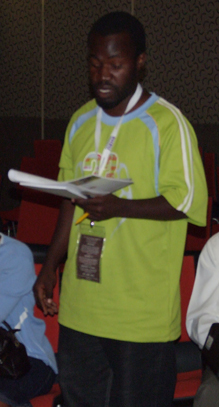
Zimbabwe delegate Alexio Mboleko
Skhumbuzo Cele, a teacher from KwaMakhutha Comprehensive High School, said he had learned a lot and was inspired by the CCE approach.
“It’s an eye-opener that sometimes working with books and standing in front of the children doesn’t work. We need to go into communities. The child belongs to a community and not only in the classrooms – so we need to realise that there’s something internal and not only external.”
Giving a brief background on the programme, Mkhize said, “The whole community conversations process last year gave birth to the process that started last week in KwaMakhutha.
“I sit and plan with facilitators [along with the key facilitator] as they prepare for the community conversation and then I observe the community conversation as it happens and as they facilitate, picking up strong points and challenges. Then I sit and reflect with them after the community conversation. It’s usually a three-day process,” explained Mkhize.
He said that getting conference delegates to use the CCE tools themselves “works much better than using a PowerPoint presentation”.
Mkhize enjoyed seeing the participants engaging and looking within for answers.
“I liked it when people were grappling with the four-quadrant approach and I observed that they had it tough with identifying individual mindsets and individual values that contribute to the spread of HIV/AIDS.”
He also noted that the participants were struggling to find matching solutions to the problems, especially in regard to values at an individual level and at a collective level.
Reflecting on the day, Nkosi said, “If you get people of different races, genders and age with one common purpose together, you achieve something that can yield results.”
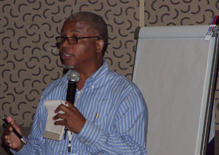
Facilitator for the session and international consultant on CCE, Tom Mkhize
Mbali Gumede, a facilitator from KwaMakhutha, said, “This whole process has taught me to have humility and to take care and put other people first.”
She said that it had been a privilege to work with the community and that it had given her a platform to say things that she could not say before.
“We all need to realise that it starts with us before it destroys the community,” Gumede noted.
Diaho’s comment was: “What I always find with this CCE methodology is how quickly people who already work in communities understand its value.”
“Secondly, how those who are being introduced to it for the first time seem to confirm the need for this philosophy in engaging communities so that all our interventions, the evidence that exists and advances in science are adopted and owned by communities.”
Diaho said she was “encouraged by the number of interested municipalities that have approached us to introduce the methodology in their communities.”
The session participants could see the tool’s potential even in the short time available to explore it, she said.
In closing, Diaho said, “It’s the fourth Southern African AIDS Conference and as in many of these conferences around the world, there was a lot of new evidence presented, more involvement of communities and an even greater number of people participating.”
Yet, much remained to be achieved in stemming the tide of new infections, giving more people access treatment and generally managing those who are already infected so that they can live normal lives. “We believe that working with communities and allowing them to guide the process at their own pace is critical and we are pleased that the communities we are working with are embracing the CCE methodology,” Diaho said.